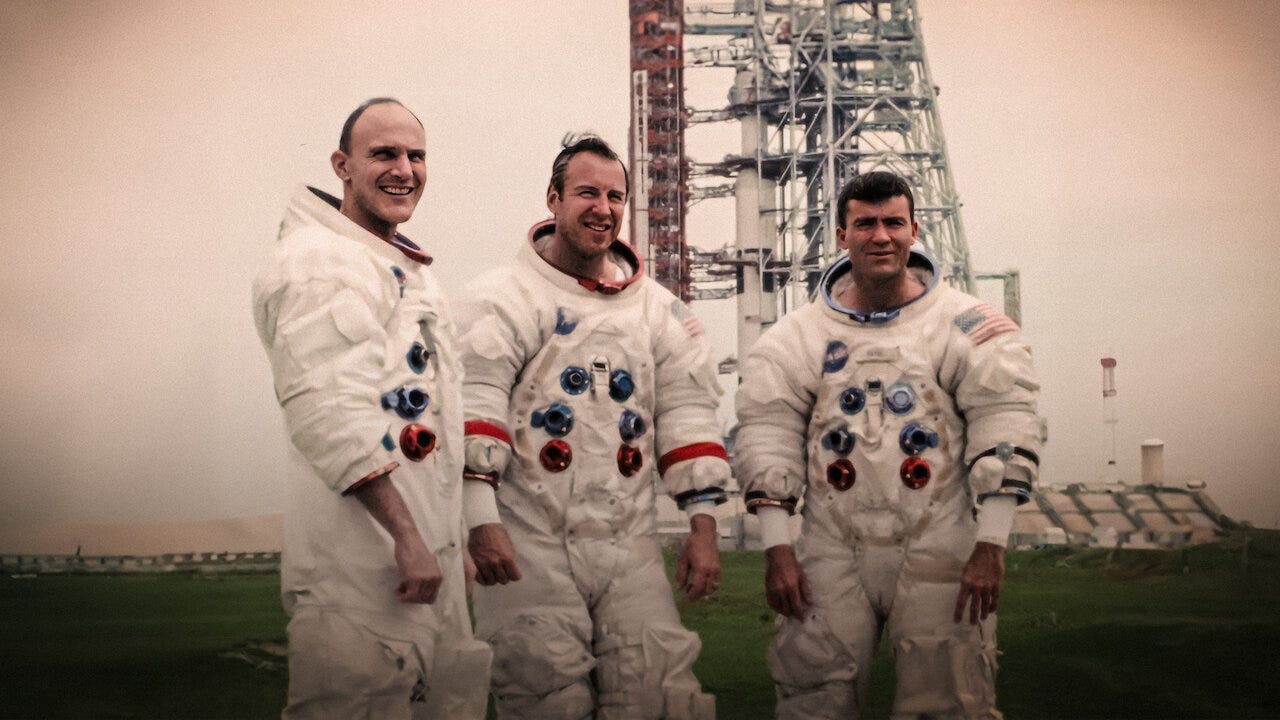Apollo 13: Survival (2024)
“America is going to the moon. Again.” The boredom in the voice of the English journalist who said those words is barely concealed, but it was the attitude of many in the media around the launch of Apollo 13.
Well, at least until the flight went to Hades and back, that is. Netflix’s new documentary, Apollo 13: Survival engagingly covers all the expected bases while filling out the thoughts and feelings of those involved in NASA’s “successful failure.”
For those who might not be familiar with Apollo 13, it always seemed doomed in one way or another. It not only sported that notoriously unlucky number but took off at 13:13 on April 11, 1970. The crew, which consisted of Commander Jim Lovell, pilot Jack Swigert, and Lunar Module pilot Fred Haise, were optimistic and excited about the mission, not unnerved in the least by superstition.
Almost immediately, things started going wrong. The center Saturn 5 engine went out, but no one thought it was a big deal. Then Swigert gave the oxygen tanks a stir, which was normally a routine procedure, but this time it caused an explosion on the ship. Instead of landing on the moon, the main objective was getting the crew back home.
Commander Jim Lovell co-wrote a book about the mission with Jeffrey Kluger called Lost Moon, which was eventually adapted into the classic 1995 feature film starring Tom Hanks. The difference between those presentations and Survival is that the filmmakers were given access to the full audio files from NASA, as well as archival footage. Footage from other missions filled in any bare spots.
Another unusual bit about Survival is that it doesn’t feature conventional interviews; we hear various participants talking over NASA footage, home movies, and the media coverage of the day. I feel a wee bit mixed about it because on one hand, sticking to archival footage keeps immersion intact, but on the other, it’s a nice personal touch if we can see the people involved.
In the end it doesn’t matter too much, because the documentary covers a tremendous amount of ground for its hour-plus-change running time. It gets personal without getting too invasive, and communicates the gravity of the situation without getting too technical, opting to show the Command Module’s instruments bouncing around and flashes of the “Abort” button. It’s less cumbersome and gets the job done.
The film also very nicely gives Lovell’s family members room to tell their side of the story, which in many ways was just as harrowing as that of the crew’s. Daughter Susan didn’t know what was going on until her classmates came up offering her condolences and support. At first she was bewildered, but then she freaked out and had to go home, where her mother was struggling to hold it together while the press milled around waiting for news.
Marilyn Lovell, Jim’s wife, compared being an astronaut’s wife to being thrown in a giant goldfish bowl. It must have been extremely difficult to put on a brave face while wondering if she would be a widow, but she did what she had to do. The timing of this documentary was fortuitous, as Marilyn passed away in August of last year.
In the fifty-plus years since Apollo 13 became NASA’s successful failure, interest in the mission has never waned. Apollo 13: Survival pays a fine tribute to everyone who had a part in that harrowing mission, whether on the ground or in outer space.
Apollo 13: Survival is currently streaming on Netflix. Rated TV-MA.
My grade: A+
Principal Cast: Neil Armstrong, Jules Bergman, James Burke, Walter Cronkite, Fred Haise, Robert Heselmeyer, Lyndon B. Johnson, Gene Kranz, Jack Lousma, Barbara Lovell, Jim Lovell, Marilyn Lovell, Susan Lovell, Glynn Lunney, Ken Mattingly, Richard Nixon, Thomas Paine, Jack Swigert.
Directed by Peter Middleton.




